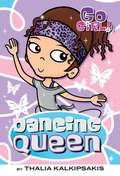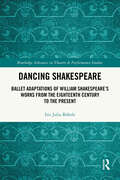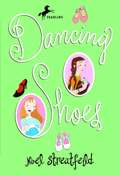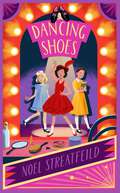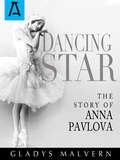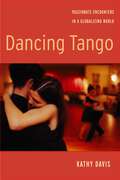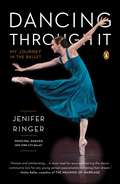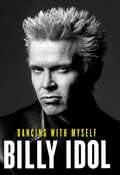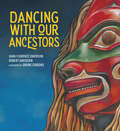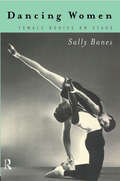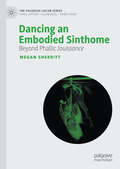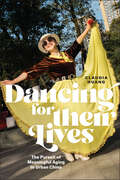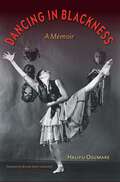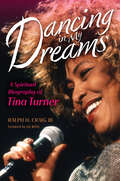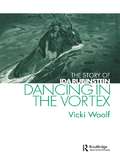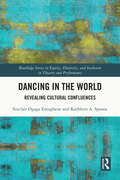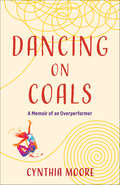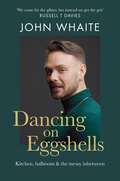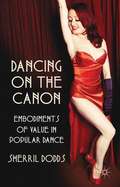- Table View
- List View
Dancing Princess (Ballerina Dreams #4)
by Ann BryantWhen two visitors show up at Poppy's ballet class looking for a single dancer to dance in a play, Poppy is determined to be the chosen one. She decides that she must be as flexible as one, and as thin as another of the students in her class. She begins doing nothing except practice, ignoring her school work, and the things that her friends want to do. She decides that if she stops eating, she can be thin enough to attract the attention of the visiting adults. Only when she faints from not eating does she reveal her secret obsessions. And only by making her angry does her mother force her to see that thinness does not make the perfect ballerina. How will accepting her humanity, her falibility and imperfection affect the decision of the adults looking for one specific dancer good enough to dance in their play?
Dancing Queen (Go Girl! #7)
by Thalia KalkipsakisShe's just had her first ever modern dance class! It's so much better than stuffy old ballet--except that the trendy girls totally tease her make fun of her outfits. But none of that seems to matter once the music plays and Charlie starts to dance...
Dancing Revolution: Bodies, Space, and Sound in American Cultural History (Music in American Life)
by Christopher J. SmithThroughout American history, patterns of political intent and impact have linked the wide range of dance movements performed in public places. Groups diverse in their cultural or political identities, or in both, long ago seized on dancing in our streets, marches, open-air revival meetings, and theaters, as well as in dance halls and nightclubs, as a tool for contesting, constructing, or reinventing the social order. Dancing Revolution presents richly diverse cases studies to illuminate these patterns of movement and influence in movement and sound in the history of American public life. Christopher J. Smith spans centuries, geographies, and cultural identities as he delves into a wide range of historical moments. These include: the God-intoxicated public demonstrations of Shakers and Ghost Dancers in the First and Second Great Awakenings; creolized antebellum dance in cities from New Orleans to Bristol; the modernism and racial integration that imbued twentieth-century African American popular dance; and public movement's contributions to hip hop, anti-hegemonic protest, and other contemporary transgressive communities’ physical expressions of dissent and solidarity. Multidisciplinary and wide-ranging, Dancing Revolution examines how Americans turned the rhythms of history into the movement behind the movements.
Dancing Shakespeare: Ballet Adaptations of William Shakespeare’s Works from the Eighteenth Century to the Present (Routledge Advances in Theatre & Performance Studies)
by Iris Julia BührleDancing Shakespeare is the first history of ballets based on William Shakespeare’s works from the birth of the dramatic story ballet in the eighteenth century to the present. It focuses on two main questions: "How can Shakespeare be danced?" and "How can dance shed new light on Shakespeare?"The book explores how librettists and choreographers have transposed Shakespeare’s complex storylines, multifaceted protagonists, rhetoric and humour into non-verbal means of expression, often going beyond the texts in order to comment on them or use them as raw material for their own creative purposes.One aim of the monograph is to demonstrate that the study of wordless performances allows us to gain a deeper understanding of Shakespeare’s texts. It argues that ballets based on Shakespeare’s works direct the audience’s attention to the "bare bones" of the plays: their situations, their characters, and the evolution of both. Moreover, they reveal and develop the "choreographies" that are written into the texts and highlight the importance of movements and gestures as signifiers in Shakespeare’s plays.This book will be of interest to students and scholars of literature, dance, and music, as well as to an international readership of lovers of Shakespeare, ballet, and the arts.
Dancing Shoes
by Noel StreatfeildAunt Cora is determined to turn two orphans, perky Hilary and sullen Rachel, into members of her dance troupe. But Rachel wants to keep Hilary from being one of Wintle's Little Wonders--is it selfishness or something else? Misunderstandings and a spoiled cousin come together for a tale full of high drama.
Dancing Shoes
by Noel StreatfeildHigh kicks and low blows are all around in this entertaining story about life at stage school - by the author of Ballet Shoes, this is perfect for young fans of shows like The Next Step, Cheer and The Greatest Dancer.It's 1957 and Rachel and Hilary are sent to live with their ambitious aunt who runs a stage school, training a troupe of dancing girls. It's heaven for Hilary who loves to perform, but quite the opposite for quiet Rachel. The last thing Rachel wants is to become one of her aunt's Little Wonders - particularly if it means behaving like their irritating show-off of a cousin . . . A mischievous, fun and moving story about young performers, from the acclaimed author of the classic Ballet Shoes.
Dancing Shoes (The Shoe Books)
by Noel StreatfeildAunt Cora is determined to turn two orphans, perky Hilary and sullen Rachel, into members of her dance troupe. But Rachel wants to keep Hilary from being one of Wintle’s Little Wonders—is it selfishness or something else? Misunderstandings and a spoiled cousin come together for a tale full of high drama. Originally published in 1957.
Dancing Star: The Story of Anna Pavlova
by Gladys MalvernIn this biographical novel, Gladys Malvern shares the incredible story of Anna Pavlova, one of the most revered and celebrated ballerinas of all time. Malvern presents Pavlova's life in enchanting prose, allowing the reader to experience Pavlova's inspirational first exposure to a performance of Sleeping Beauty, the origination of her defining dance The Dying Swan, her illustrious rise to fame as a prima ballerina, and her extensive world tours. You don't have to be a fan of the ballet to enjoy this captivating tale, available for the first time in ebook.
Dancing Tango: Passionate Encounters in a Globalizing World
by Kathy DavisArgentinean tango is a global phenomenon. Since its origin among immigrants from the slums of Buenos Aires and Montevideo, it has crossed and re-crossed many borders.Yet, never before has tango been danced by so many people and in so many different places as today. Argentinean tango is more than a specific music and style of dancing. It is also a cultural imaginary which embodies intense passion, hyper-heterosexuality, and dangerous exoticism.In the wake of its latest revival, tango has become both a cultural symbol of Argentinean national identity and a transnational cultural space in which a modest, yet growing number of dancers from different parts of the globe meet on the dance floor.Through interviews and ethnographical research in Amsterdam and Buenos Aires, Kathy Davis shows why a dance from another era and another place appeals to men and women from different parts of the world and what happens to them as they become caught up in the tango salon culture. She shows how they negotiate the ambivalences, contradictions, and hierarchies of gender, sexuality, and global relations of power between North and South inwhich Argentinean tango is—and has always been—embroiled.Davis also explores her uneasiness about her own passion for a dance which—when seen through the lens of contemporary critical feminist and postcolonial theories—seems, at best, odd, and, at worst, disreputable and even a bit shameful. She uses the disjuncture between the incorrect pleasures and complicated politics of dancing tango as a resource for exploring the workings of passion as experience, as performance, and as cultural discourse. She concludes that dancing tango should be viewed less as a love/hate embrace with colonial overtones than a passionate encounter across many different borders between dancers who share a desire for difference and a taste of the ‘elsewhere.’ Dancing Tango is a vivid, intriguing account of an important global cultural phenomenon.
Dancing Through It
by Jenifer RingerA behind-the-curtains look at the rarefied world of classical ballet from a principal dancer at the New York City Ballet In her charming and self-effacing voice, Jenifer Ringer covers the highs and lows of what it's like to make it to the top in the exclusive, competitive ballet world. From the heart-pounding moments waiting in the wings before a performance to appearing on Oprah to discuss weight and body image among dancers, Dancing Through It is moving and revelatory. Raised in South Carolina, Ringer led a typical kid's life until she sat in on a friend's ballet class, an experience that would change her life forever. By the age of twelve she was enrolled at the elite Washington School of Ballet and soon moved to the School of American Ballet. At sixteen she was a professional dancer at the New York City Ballet in Manhattan, home of the legendary George Balanchine and Jerome Robbins. Ringer takes us inside the dancer's world, detailing a typical day, performance preparation, and the extraordinary pressures that these athletes face. Ringer shares exhilarating stories of starring in Balanchine productions, working with the famous Peter Martins, and of meeting her husband and falling in love at the New York City Ballet. Ringer also talks candidly of Alistair Macauley's stinging critique of her weight in his 2010 New York Times review of The Nutcracker that ignited a public dialogue about ballet and weight. She unflinchingly describes her personal struggles with eating disorders and body image, and shares how her faith helped her to heal and triumph over these challenges.
Dancing With Myself
by Billy IdolIn this bold and candid memoir, music legend Billy Idol shares his life story—from his childhood in England to his rise to fame during the height of the punk-pop revolution—revealing intimate details about the sex, drugs, and rock and roll that he is so fabulously famous for—all told in his own utterly indelible voice.<P> An integral member of the punk rock revolution whose music crossed over into ’80s pop mainstream—and one of MTV’s first stars—Billy Idol remains an iconic music legend. Now, in his long-awaited Dancing With Myself, he delivers a lively, candid account of his journey to fame—including intimate and unapologetic details about his life’s highs and lows—all rendered with the in-your-face attitude and exuberance his fans have embraced. Idol brings to life the key events that shaped his life, his music, and his career, including his early childhood in England, his year at Sussex University, and his time spent hanging out with the Sex Pistols and as a member of punk bands Chelsea and Generation X.<P> He shares outtakes from his wildly and unexpectedly successful solo career and stories behind his string of popular hits, including “White Wedding,” “Eyes Without a Face,” and “Rebel Yell,” which involved close collaboration with Steve Stevens and ultimately led to the creation of some of the most groundbreaking music videos ever seen.<P> Dancing With Myself is both a tale of survival and a celebration of the heady days when punk was born—a compelling and satisfying insider’s tale from a man who made music history firsthand.
Dancing With Our Ancestors (Sk'ad'a Stories Series)
by Robert Davidson Sara Florence DavidsonIn this tender picture book, Sara Florence Davidson transports readers to the excitement of a potlatch in Hydaburg, Alaska—her last memory of dancing with her late brother.It feels like my brother and I have always known how to sing the songs and dance the dances of our Haida ancestors. Unlike our father, we were born after the laws that banned our cultural practices were changed. The potlatch ban did not exist during our time, so we grew up dancing and singing side by side.The invitations have been sent. The food has been prepared. The decorations have been hung. And now the day of the potlatch has finally arrived! Guests from all over come to witness this bittersweet but joyful celebration of Haida culture and community.Written by the creators of Potlatch as Pedagogy, this book brings the Sk'ad'a Principles to life through the art of Janine Gibbons.
Dancing With Our Ancestors (Sk'ad'a Stories Series)
by Robert Davidson Sara Florence DavidsonIn this tender picture book, Sara Florence Davidson transports readers to the excitement of a potlatch in Hydaburg, Alaska—her last memory of dancing with her late brother.It feels like my brother and I have always known how to sing the songs and dance the dances of our Haida ancestors. Unlike our father, we were born after the laws that banned our cultural practices were changed. The potlatch ban did not exist during our time, so we grew up dancing and singing side by side.The invitations have been sent. The food has been prepared. The decorations have been hung. And now the day of the potlatch has finally arrived! Guests from all over come to witness this bittersweet but joyful celebration of Haida culture and community.Written by the creators of Potlatch as Pedagogy, this book brings the Sk'ad'a Principles to life through the art of Janine Gibbons.
Dancing Women: Female Bodies Onstage
by Sally BanesDancing Women: Female Bodies Onstage is a spectacular and timely contribution to dance history, recasting canonical dance since the early nineteenth century in terms of a feminist perspective. Setting the creation of specific dances in socio-political and cultural contexts, Sally Banes shows that choreographers have created representations of women that are shaped by - and that in part shape - society's continuing debates about sexuality and female identity. Broad in its scope and compelling in its argument Dancing Women: * provides a series of re-readings of the canon, from Romantic and Russian Imperial ballet to contemporary ballet and modern dance * investigates the gaps between plot and performance that create sexual and gendered meanings * examines how women's agency is created in dance through aspects of choreographic structure and style * analyzes a range of women's images - including brides, mistresses, mothers, sisters, witches, wraiths, enchanted princesses, peasants, revolutionaries, cowgirls, scientists, and athletes - as well as the creation of various women's communities on the dance stage * suggests approaches to issues of gender in postmodern dance Using an interpretive strategy different from that of other feminist dance historians, who have stressed either victimization or celebration of women, Banes finds a much more complex range of cultural representations of gender identities.
Dancing an Embodied Sinthome: Beyond Phallic Jouissance (The Palgrave Lacan Series)
by Megan SherrittThis book provides the first in-depth analysis of Lacanian psychoanalytic theory and the art of dance and explores what each practice can offer the other. It takes as its starting point Jacques Lacan’s assertion that James Joyce’s literary works helped him create what Lacan terms a sinthome, thereby preventing psychosis. That is, Joyce’s use of written language helped him maintain a “normal” existence despite showing tendencies towards psychosis. Here it is proposed that writing was only the method through which Joyce worked but that the key element in his sinthome was play, specifically the play of the Lacanian real.The book moves on to consider how dance operates similarly to Joyce’s writing and details the components of Joyce’s sinthome, not as a product that keeps him sane, but as an interminable process for coping with the (Lacanian) real. The author contends that Joyce goes beyond words and meaning, using language’s metre, tone, rhythm, and cadence to play with the real, mirroring his experience of it and confining it to his works, creating order in the chaos of his mind. The art of dance is shown to be a process that likewise allows one to play with the real. However, it is emphasized that dance goes further: it also teaches someone how to play if one doesn't already know how. This book offers a compelling analysis that sheds new light on the fields of psychoanalysis and dance and looks to what this can tell us about—and the possibilities for—both practices, concluding that psychoanalysis and dance both offer processes that open possibilities that might otherwise seem impossible. This original analysis will be of particular interest to those working in the fields of psychoanalysis, aesthetics, psychoanalytic theory, critical theory, art therapy, and dance studies.
Dancing at the Dawn of Agriculture
by Yosef GarfinkelAs the nomadic hunters and gatherers of the ancient Near East turned to agriculture for their livelihood and settled into villages, religious ceremonies involving dancing became their primary means for bonding individuals into communities and households into villages. So important was dance that scenes of dancing are among the oldest and most persistent themes in Near Eastern prehistoric art, and these depictions of dance accompanied the spread of agriculture into surrounding regions of Europe and Africa. In this pathfinding book, Yosef Garfinkel analyzes depictions of dancing found on archaeological objects from the Near East, southeastern Europe, and Egypt to offer the first comprehensive look at the role of dance in these Neolithic (7000-4000 BC) societies. In the first part of the book, Garfinkel examines the structure of dance, its functional roles in the community (with comparisons to dance in modern pre-state societies), and its cognitive, or symbolic, aspects. This analysis leads him to assert that scenes of dancing depict real community rituals linked to the agricultural cycle and that dance was essential for maintaining these calendrical rituals and passing them on to succeeding generations. In the concluding section of the book, Garfinkel presents and discusses the extensive archaeological data—some 400 depictions of dance—on which his study is based.
Dancing for Their Lives: The Pursuit of Meaningful Aging in Urban China (Global Perspectives on Aging)
by Claudia HuangDancing for Their Lives explores the vibrant world of retired Chinese women known as "dancing grannies” who seek fulfillment and companionship amidst societal upheaval. These women, part of China’s “lost generation,” gather in parks and public squares to reclaim their lives through dance in the wake of Chinese economic and cultural transformations. The book challenges prevailing narratives of aging societies, portraying old age as a site of social innovation rather than decline. Based on ethnographic research conducted in Chengdu, China, Dancing for Their Lives reveals how retirees learn to navigate shifting social norms and values while actively creating new models for growing older. The book’s insights resonate beyond Chinese society, offering lessons on resilience and the pursuit of meaning in any aging population. Dancing for Their Lives underscores the human capacity to craft purposeful lives amid uncertainty, transcending geographical boundaries to illuminate the universal quest for fulfillment in later years.
Dancing in Blackness: A Memoir
by Halifu OsumareDancing in Blackness is a professional dancer's personal journey over four decades, across three continents and 23 countries, and through defining moments in the story of black dance in America. In this memoir, Halifu Osumare reflects on what blackness and dance have meant to her life and international career. Osumare's story begins in 1960s San Francisco amid the Black Arts Movement, black militancy, and hippie counterculture. It was there, she says, that she chose dance as her own revolutionary statement. Osumare describes her experiences as a young black dancer in Europe teaching "jazz ballet" and establishing her own dance company in Copenhagen. Moving to New York City, she danced with the Rod Rodgers Dance Company and took part in integrating the programs at the Lincoln Center. After doing dance fieldwork in Ghana, Osumare returned to California and helped develop Oakland’s black dance scene. Osumare introduces readers to some of the major artistic movers and shakers she collaborated with throughout her career, including Katherine Dunham, Pearl Primus, Jean-Leon Destine, Alvin Ailey, and Donald McKayle. Now a black studies scholar, Osumare uses her extraordinary experiences to reveal the overlooked ways that dance has been a vital tool in the black struggle for recognition, justice, and self-empowerment. Her memoir is the inspiring story of an accomplished dance artist who has boldly developed and proclaimed her identity as a black woman.
Dancing in My Dreams: A Spiritual Biography of Tina Turner (Library of Religious Biography (LRB))
by Ralph H. CraigIf you don&’t know Tina Turner&’s spirituality, you don&’t know Tina. When Tina Turner reclaimed her throne as the Queen of Rock &‘n&’ Roll in the 1980s, she attributed her comeback to one thing: the wisdom and power she found in Buddhism. Her spiritual transformation is often overshadowed by the rags-to-riches arc of her life story. But in this groundbreaking biography, Ralph H. Craig III traces Tina&’s journey from the Black Baptist church to Buddhism and situates her at the vanguard of large-scale movements in religion and pop culture. Paying special attention to the diverse metaphysical beliefs that shaped her spiritual life, Craig untangles Tina&’s Soka Gakkai Buddhist foundation; her incorporation of New Age ideas popularized in &’60s counterculture; and her upbringing in a Black Baptist congregation, alongside the influences of her grandmothers&’ disciplinary and mystical sensibilities. Through critical engagement with Tina&’s personal life and public brand, Craig sheds light on how popular culture has been used as a vehicle for authentic religious teaching. Scholars and fans alike will find Dancing in My Dreams as enlightening as the iconic singer herself.
Dancing in the Vortex: The Story of Ida Rubinstein (Choreography and Dance Studies Series #Vol. 20.)
by Vicki WoolfParis at the turn of the century - Art Nouveau, Renoir, Toulouse-Lautrec and the Folies Bergere. This was the atmosphere which nurtured the artistic development of the remarkable dancer and choreographer Ida Rubinstein.This long-awaited biography gives us a unique insight into the life of a remarkable woman, responsible for a fascinating chapter of our artistic heritage. She was a chameleon, a diva, who lived many lives, overcoming the anti-Semitism of her times to enchant and captivate the highest of societies.Untrained as a dancer, Ida Rubinstein's charisma attracted collaborators such as Debussy, Stravinsky, Ravel, Cocteau, Bakst, and Benois.
Dancing in the World: Revealing Cultural Confluences (Routledge Series in Equity, Diversity, and Inclusion in Theatre and Performance)
by Sinclair Ogaga Emoghene Kathleen A. SpanosHow can we create more inclusive spaces in the field of dance? This book presents a framework for dance practitioners and researchers working in diverse dance cultures to navigate academia and the professional dance field. The framework is based on the idea of "cultural confluences," conjuring up an image of bodies of water meeting and flowing into and past one another, migrating through what they refer to as the mainstream and non-mainstream. These streams are fluid categories that are associated with power, privilege, and the ability (or inability) to absorb other cultural forms in shared dance spaces. In reflective interludes and dialogues, Emoghene and Spanos consider the effects of migration on their own individual experiences in dance to understand what it means to carry culture through the body in various spaces. Through an analysis of language, aesthetic values, spaces, creative processes, and archival research practices, the book offers a collaborative model for communicating the value that marginalized dance communities bring to the field. This book will be of great interest to students, scholars, and arts administrators in dance.
Dancing on Coals: A Memoir of an Overperformer
by Cynthia MooreAn award-winning playwright's story of her madcap race to find fame or enlightenment, whichever comes first— perfect for fans of Lori Gottlieb's Maybe You Should Talk to Someone.In Dancing on Coals, Cynthia Moore describes a multi-decade, harebrained search for love in all the wrong places, starting when her narcissistic mother abandons her to a Swiss finishing school. Desperately seeking belonging, she leapfrogs from a polyamorous commune into a high-octane all-male performance group, dancing as if her life depends on it. When she finally quits the theater, earns a masters degree in psychology and develops her own therapeutic approach, she is able to heal herself and find the true belonging and peace she longs for. At times humorous and self-deprecating, at times poignant and heartbreaking, this is the story of one woman's path from abandonment to wholeness and authenticity.
Dancing on Eggshells: Kitchen, ballroom & the messy inbetween
by John Whaite'We come for the glitter, but instead we get the grit, in stories told with insight, tenderness and joy.' - Russell T DaviesWith a foreword by Steph McGovern'I never thought I'd write a memoir. I never thought I'd do a lot of the things I have done in my thirty-four years, but life has a wonderful way of surprising us.'Well-known as the winner of the third series of The Great British Bake Off and runner up of Strictly Come Dancing with his same-sex dance partner Johannes Radebe, John Whaite's personal story is a complicated narrative of contradictions, highs and lows, told with tenderness, joy, insight and wit, but also unflinching honesty. A shy little boy from rural Lancashire, who was scared to sleep alone and danced a little 'too gay' at family weddings, he was also an unruly teen who shaved a checkerboard pattern into his hair and refused to conform. From childhood his life has revolved around food - his parents owned a fish and chip shop where John worked in the back peeling potatoes - but for long periods he has been haunted by bulimia and body dysmorphia and not a day goes by when he doesn't worry about what or how much he eats. He achieved TV fame but then seemingly wilfully chose to self-destruct, before finding the strength to pull back when he woke up in a car with half a kebab at his feet and chilli sauce on his shoes. Through it all, his essential optimism has meant that he has chosen to take every step back as a chance to reassess and begin again, finally arriving at the realisation that external validation and fulfilment is transient - a distraction from the sometimes painful pilgrimage we make as we gain wisdom from our experiences.
Dancing on Eggshells: Kitchen, ballroom & the messy inbetween
by John Whaite'We come for the glitter, but instead we get the grit, in stories told with insight, tenderness and joy.' - Russell T DaviesWith a foreword by Steph McGovern'I never thought I'd write a memoir. I never thought I'd do a lot of the things I have done in my thirty-four years, but life has a wonderful way of surprising us.'Well-known as the winner of the third series of The Great British Bake Off and runner up of Strictly Come Dancing with his same-sex dance partner Johannes Radebe, John Whaite's personal story is a complicated narrative of contradictions, highs and lows, told with tenderness, joy, insight and wit, but also unflinching honesty. A shy little boy from rural Lancashire, who was scared to sleep alone and danced a little 'too gay' at family weddings, he was also an unruly teen who shaved a checkerboard pattern into his hair and refused to conform. From childhood his life has revolved around food - his parents owned a fish and chip shop where John worked in the back peeling potatoes - but for long periods he has been haunted by bulimia and body dysmorphia and not a day goes by when he doesn't worry about what or how much he eats. He achieved TV fame but then seemingly wilfully chose to self-destruct, before finding the strength to pull back when he woke up in a car with half a kebab at his feet and chilli sauce on his shoes. Through it all, his essential optimism has meant that he has chosen to take every step back as a chance to reassess and begin again, finally arriving at the realisation that external validation and fulfilment is transient - a distraction from the sometimes painful pilgrimage we make as we gain wisdom from our experiences.
Dancing on the Canon
by Sherril DoddsEmploying a cultural theory approach, thisbook explores the relationship between popular dance and value. It traces the shifting value systems that underpin popular dance scholarship and considers how different dancing communities articulate complex expressions of judgment, significance and worth through their embodied practice. "

